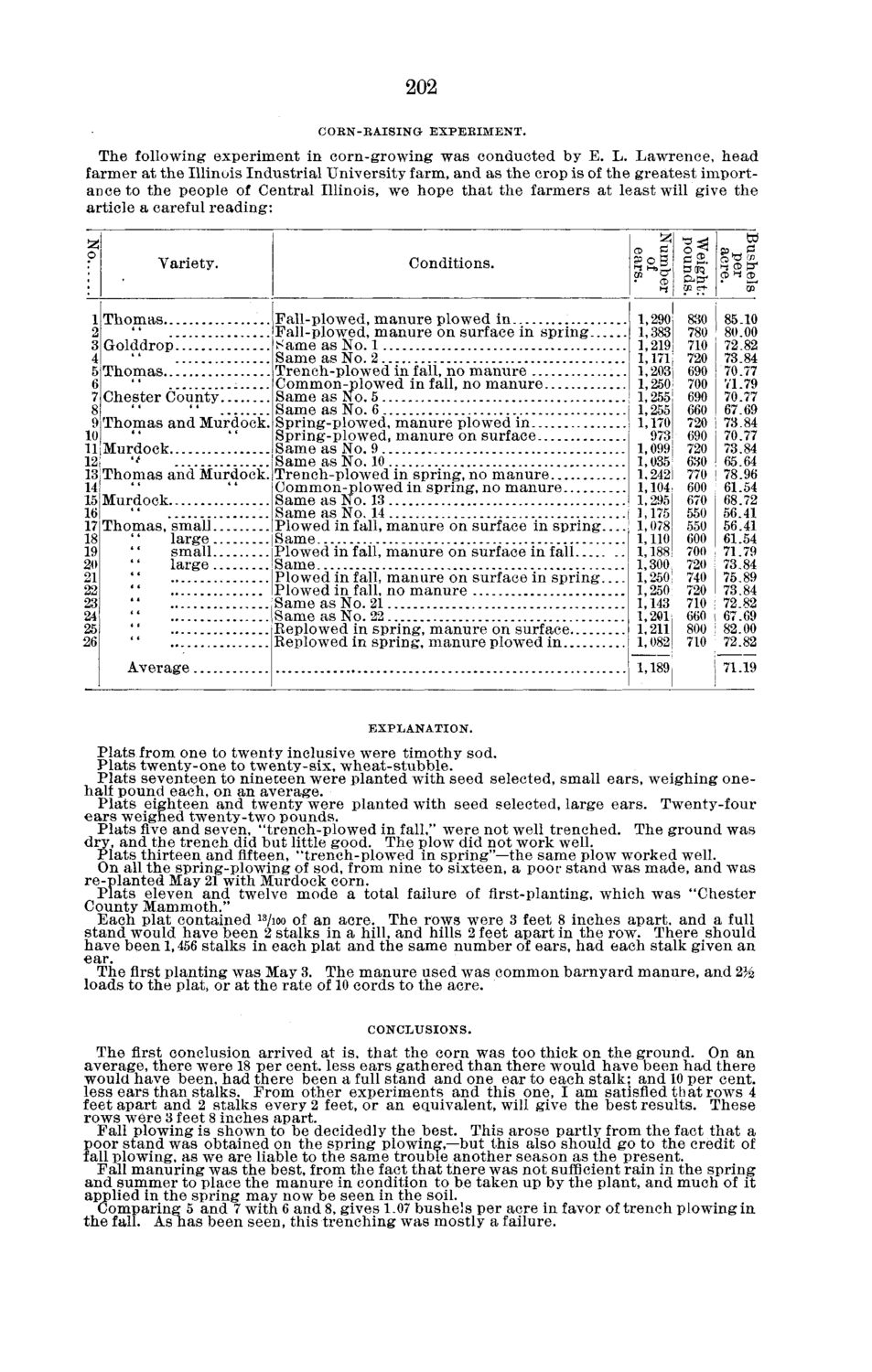| |
| |
Caption: Board of Trustees Minutes - 1880
This is a reduced-resolution page image for fast online browsing.

EXTRACTED TEXT FROM PAGE:
202 CORN-KAISINC- EXPERIMENT. The following experiment in corn-growing was conducted by E. L. Lawrence, head farmer at the Illinois Industrial University farm, and as the crop is of the greatest importance to the people of Central Illinois, we hope that the farmers at least will give the article a careful reading: C D £ w 0 2. pip3 C £3D CD '"S CD Yariety. Thomas... (xolddrop. Thomas... Conditions. Fall-plowed, manure plowed in Fall-plowed, manure on surface in spring... Same as No. 1 Same as No. 2 Trench-plow^ed in fall, no manure Common-plowed in fall, no manure Same as No. 5 Chester Coxinty Same as No. 6 Spring-plowed, manure plowed in Thomas and Murdock. Spring-plowed, manure on surface Same as No. 9 Murdock Same as No. 10 Trench-plowed in spring, no manure Thomas and Murdock. Common-plowed in spring, no manure Same as No. 13 Murdock Same as No. 14 Thomas, small, Plowed in fall, manure on surface in spring. large. Same small, Plowed in fall, manure on surface in fall large. Same Plowed in fall, manure on surface in spring.. Plowed in fall, no manure Same as No. 21 Same as No. 22 Eeplowed in spring, manure on surface Beplowed in spring, manure plowed in Average I 1,290 1,383 1,2191 1,171 1,203 1,2501 1,255 1,255 1,170 973 1,099 1,035 1,242 1,104 1,295 U75 1,078 1,110 1,188! 1,300, 1,250! 1,250! 1,143 1,201 1,211 1,082 I 1,189 830 780 710 720 690 700 690 660 720 690 720 630 770 600 670 550 550 600 700 720 740 720 710 660 800 710 85.10 80.00 72.82 73.84 70.77 71.79 70.77 67.69 73.84 70.77 73.84 65.64 78.96 61.54 68.72 56.41 56.41 61.54 71.79 73.84 75.89 73.84 72.82 67.69 82.00 72.82 71.19 EXPLANATION. Plats from one to twenty inclusive were timothy sod. Plats twenty-one to twenty-six, wheat-stubble. Plats seventeen to nineteen were planted with seed selected, small ears, weighing onehalf pound each, on an average. Plats eighteen and twenty were planted with seed selected, large ears. Twenty-four ears weighed twenty-two pounds. Plats five and seven, "trench-plowed in fall," were not well trenched. The ground was dry, and the trench did but little good. The plow did not work well. Plats thirteen and fifteen, "trench-plowed in spring"—the same plow worked well. On all the spring-plowing of sod, from nine to sixteen, a poor stand was made, and was re-planted May 21 with Murdock corn. Plats eleven and twelve mode a total failure of first-planting, which was "Chester County Mammoth." 13 Each plat contained /ioo of an acre. The rows were 3 feet 8 inches apart, and a full stand would have been 2 stalks in a hill, and hills 2 feet apart in the row. There should have been 1,456 stalks in each plat and the same number of ears, had each stalk given an ear. The first planting was May 3. The manure used was common barnyard manure, and 2^ loads to the plat, or at the rate of 10 cords to the acre. CONCLUSIONS. The first conclusion arrived at is. that the corn was too thick on the ground. On an average, there were 18 per cent, less ears gathered than there would have been had there would have been, had there been a full stand and one ear to each stalk; and 10 per cent, less ears than stalks. From other experiments and this one, I am satisfied that rows 4 feet apart and 2 stalks every 2 feet, or an equivalent, will give the best results. These rows were 3 feet 8 inches apart. Fall plowing is shown to be decidedly the best. This arose partly from the fact that a poor stand was obtained on the spring plowing,—but this also should go to the credit of fall plowing, as we are liable to the same trouble another season as the present. Fall manuring was the best, from the fact that tnere was not sufficient rain in the spring and summer to place the manure in condition to be taken up by the plant, and much of it applied in the spring may now be seen in the soil. Comparing 5 and 7 with 6 and 8, gives 1.07 bushels per acre in favor of trench plowing in the fall. As has been seen, this trenching was mostly a failure.
| |